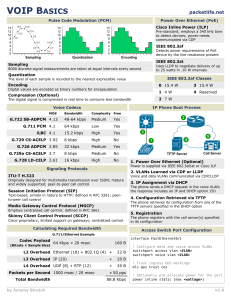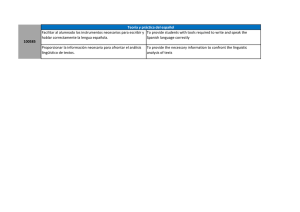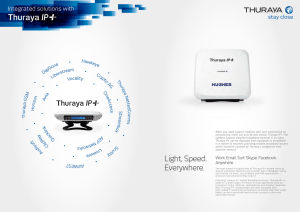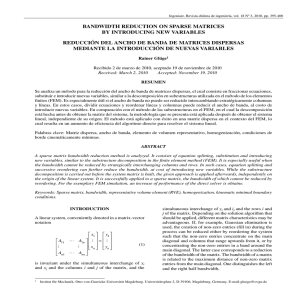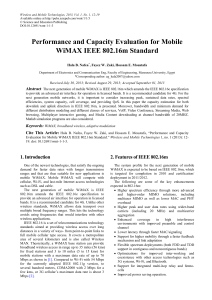Análisis de requerimiento de mayor ancho de banda del enlace de
Anuncio
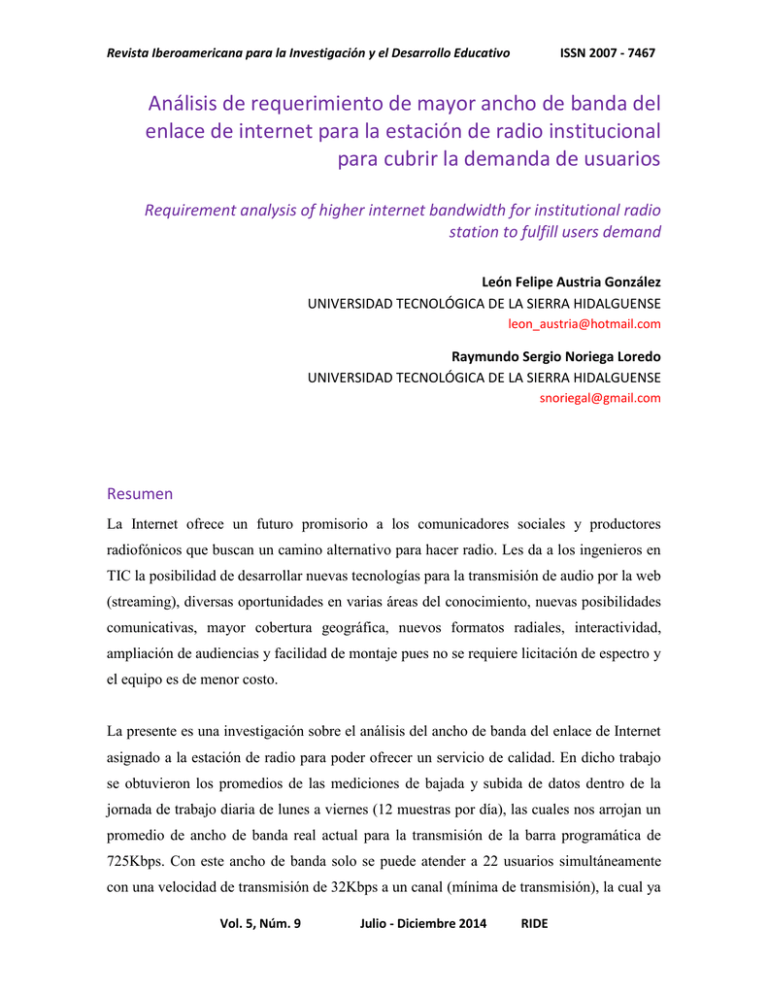
Revista Iberoamericana para la Investigación y el Desarrollo Educativo ISSN 2007 - 7467 Análisis de requerimiento de mayor ancho de banda del enlace de internet para la estación de radio institucional para cubrir la demanda de usuarios Requirement analysis of higher internet bandwidth for institutional radio station to fulfill users demand León Felipe Austria González UNIVERSIDAD TECNOLÓGICA DE LA SIERRA HIDALGUENSE [email protected] Raymundo Sergio Noriega Loredo UNIVERSIDAD TECNOLÓGICA DE LA SIERRA HIDALGUENSE [email protected] Resumen La Internet ofrece un futuro promisorio a los comunicadores sociales y productores radiofónicos que buscan un camino alternativo para hacer radio. Les da a los ingenieros en TIC la posibilidad de desarrollar nuevas tecnologías para la transmisión de audio por la web (streaming), diversas oportunidades en varias áreas del conocimiento, nuevas posibilidades comunicativas, mayor cobertura geográfica, nuevos formatos radiales, interactividad, ampliación de audiencias y facilidad de montaje pues no se requiere licitación de espectro y el equipo es de menor costo. La presente es una investigación sobre el análisis del ancho de banda del enlace de Internet asignado a la estación de radio para poder ofrecer un servicio de calidad. En dicho trabajo se obtuvieron los promedios de las mediciones de bajada y subida de datos dentro de la jornada de trabajo diaria de lunes a viernes (12 muestras por día), las cuales nos arrojan un promedio de ancho de banda real actual para la transmisión de la barra programática de 725Kbps. Con este ancho de banda solo se puede atender a 22 usuarios simultáneamente con una velocidad de transmisión de 32Kbps a un canal (mínima de transmisión), la cual ya Vol. 5, Núm. 9 Julio - Diciembre 2014 RIDE Revista Iberoamericana para la Investigación y el Desarrollo Educativo ISSN 2007 - 7467 no es suficiente para atender la demanda actual. Los usuarios potenciales para conectar a diario simultáneamente son 31 alrededor del mundo comprendidos por 18 países. Para atender la demanda actual y ofrecer un servicio de calidad de streaming (transmisión de programas radiofónicos) se requiere incrementar y contar con un ancho de banda de 4Mbps (2 Mbps de subida y 2 Mbps de bajada de datos si fuera simétrica). Palabras clave: Ancho de Banda, streaming, transmisión, bajada y subida de datos. Abstract Internet offers a promising future to social communicators and radio producers who seek an alternative pathway to make radio. It gives Information and Communications Technology (ICT) engineers the possibility of developing new technologies for audio transmission through the web (streaming), diverse opportunities in several areas of knowledge, new communicative possibilities, greater geographic coverage, new radio formats, interactivity, larger audiences and ease setup as a bid is not required for spectrum and equipment is lower cost. This is a research on the analysis of the Network Bandwidth assigned to a radio station to offer a quality service. In such work the average measurements were calculated for of descent and ascent of data within the daily working day from Monday to Friday (12 samples per day), which shed us an average of current actual bandwidth for the programmes transmission of 725 Kbps. With this bandwidth only 22 users can attend simultaneously with a transmission rate of 32 Kbps to one channel (minimum of transmission), which is already not enough to meet the current demand. The potential users to connect daily and simultaneously are 31 around the globe spread over 18 countries. To meet the current demand and offer a quality streaming service (transmission of radio programmes), an increase and access to a bandwidth of 4Mbps is required (2 Mbps of upload and 2 Mbps of data down if it were symmetrical. Key Words: Bandwidth, streaming, descent and ascent of data transmission. Fecha recepción: Marzo 2014 Vol. 5, Núm. 9 Fecha aceptación: Junio 2014 Julio - Diciembre 2014 RIDE Revista Iberoamericana para la Investigación y el Desarrollo Educativo ISSN 2007 - 7467 Introduction With the arrival of new information and communication technologies, the possibility of expansion has grown for both, broadcasters and radio producers, as well as for software developers and Information and Communication Technology Engineers (ICT). The Internet clears the present and opens a promising future. The amplitude modulated (AM) and frequency modulated (FM) radio has no room for the concession of more frequencies because the electromagnetic spectrum is saturated and monopolized. For this reason, social communicators and radio producers should look for an alternative path to making radio, where ICT engineers had the ability to develop new technologies for audio transmission over the web (streaming). Justification From the academic point of view, the Internet radio becomes another academic resource to stimulate the development of academies in the institutions, the professional development and the productive sector, thus contributing to the progress of the country. Because this is an interactive, highly flexible and autonomous channel, it also contributes to the decentralization of knowledge, allowing the user to use their creativity to generate their own content and express it freely. Also, this research on the analysis of the requirement of higher bandwidth for radio station broadcasting, is intended to meet a real project, approved by the society and community, regional, national and from abroad (e.g., the countrymen who for some reason emigrated to other countries and using the radio to get closer to their family and friends). With the creation and implementation of Internet Radio Station "UT Radio of Hidalgo Mountain Range", it contributes to the indirect development of students for careers in Information Technologies and Communication, musicians, amateur radio and the Internet itself with quality content. In the same way, the Institution links to the education sector, the productive sector and the regional population of Hidalgo Mountain Rage, positioning the Technological University Of Hidalgo Mountain Range (UTSH) at the forefront of telecommunications. Vol. 5, Núm. 9 Julio - Diciembre 2014 RIDE Revista Iberoamericana para la Investigación y el Desarrollo Educativo ISSN 2007 - 7467 Development To obtain measurements of descent and ascent of data averages, 12 daily measurements were made from 8 am at 7 pm. This schedule was taken as basis since it is when a greater number of users connected to Internet is registered and there are staff on the radio for its monitoring. During the period of one week following measurements were obtained (see Table 1). Table 1. Average of bandwidth in Kbps weekday. Hour 8 am 9 am 10 am 11 am 12 am 1 pm 2 pm 3 pm 4 pm 5 pm 6 pm 7 pm Download 815 Kbps 260 Kbps 920 Kbps 680 Kbps 860 Kbps 445 Kbps 753 Kbps 520 Kbps 465 Kbps 290 Kbps 650 Kbps 340 Kbps Upload 1355 Kbps 540 Kbps 660 Kbps 570 Kbps 785 Kbps 650 Kbps 670 Kbps 875 Kbps 660 Kbps 500 Kbps 740 Kbps 415 Kbps The following reasoning was used to measure the maximum number of users: M = Maximum users may simultaneously connect to the server at a specified time (streaming connections). A = measurement bandwidth available at that time (Kbps). T = traffic from other network services to the internet at that time (Kbps). S = speed streaming service offered (32 Kbps). D = number of sampled days (Monday - Friday). D M = [∑ (Ai – Ti) / S] / D i=1 Vol. 5, Núm. 9 Julio - Diciembre 2014 RIDE Revista Iberoamericana para la Investigación y el Desarrollo Educativo ISSN 2007 - 7467 In Figure 1 we can see the behavior graph of bandwidth that is assigned to the Institutional station radio. As seen in the morning between the hours of 8-9 am, it has a width of almost free band as is assumed by the few users connected to the Internet in college (person and students); between 10 and 12 am there is greater demand for users and is not possible to provide service to more than 22 people, plus the service offered is not of good quality (32 Kbps). Throughout the day the bandwidth offered is on average 725Kbps, as it is when users of the network and university Internet are connected and sharing our link, and evenings lower bandwidth offered in the broadcasts programs, generating complaints from listeners and speakers of the station. In sum, the evening is when more people in the organization connects to the Internet, in addition to the service offered by the company that supplied (TELMEX) is not guaranteeing bandwidth offered. 1600 1400 1200 1000 BAJADA 800 SUBIDA 600 400 200 0 8 9 10 11 12 13 14 15 16 17 18 19 The maximum number of simultaneously connected users is shown in Table 2. Vol. 5, Núm. 9 Julio - Diciembre 2014 RIDE Revista Iberoamericana para la Investigación y el Desarrollo Educativo ISSN 2007 - 7467 Table 1. Average maximum users connect at different times on weekdays. Hour Máximo de usuarios 8 am 9 am 10 am 11 am 12 am 1 pm 2 pm 3 pm 4 pm 5 pm 6 pm 7 pm 42 17 21 18 25 20 21 27 21 16 23 13 The above measurements show an average current actual band width for transmission of program bar 725Kbps. With this bandwidth can be met only on average 22 users simultaneously with a transmission speed of 32Kbps to a channel (minimum transmission), which is sufficient to meet current demand. Potential to connect daily are 31 users simultaneously around the world (see Figure 2), included in 18 countries (see Table 3). To meet current demand and provide quality service streaming (transmission of radio programs) is required to increase and have a 4Mbps bandwidth (2Mbps upload and 2 Mbps downlink data if symmetrical). Vol. 5, Núm. 9 Julio - Diciembre 2014 RIDE Revista Iberoamericana para la Investigación y el Desarrollo Educativo ISSN 2007 - 7467 FIGURE 2. Image statistics page for the domain of radio. Table 3. Statistical percentage of users in the countries who listen to us (estadisticasgratis.com). Vol. 5, Núm. 9 Julio - Diciembre 2014 RIDE Revista Iberoamericana para la Investigación y el Desarrollo Educativo ISSN 2007 - 7467 Conclusion To ensure quality Internet radio service that offers UTSH regarding the number of users connecting and continue this process of communication requires that coverage be extended with a bandwidth of 4Mbps. With such coverage is to harness the bandwidth and improve the services offered by radio outreach of health, science and technology, education, social, culture, arts, traditions and rescue the indigenous language. Bibliography http://www.estadisticas-gratis.com/estadisticas/?id=29a352ccdbe28cde3f525efc6cb3e57c http://www.utsh.edu.mx/php/inicio.php Vol. 5, Núm. 9 Julio - Diciembre 2014 RIDE
